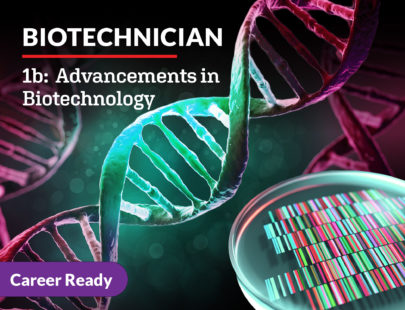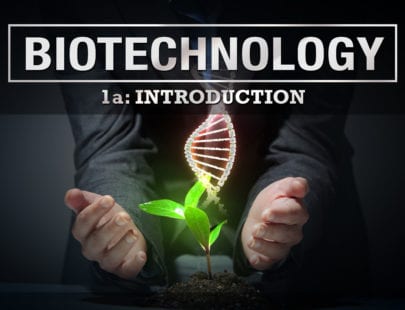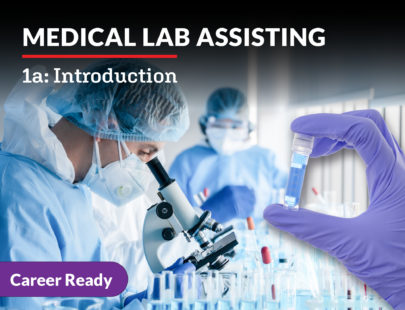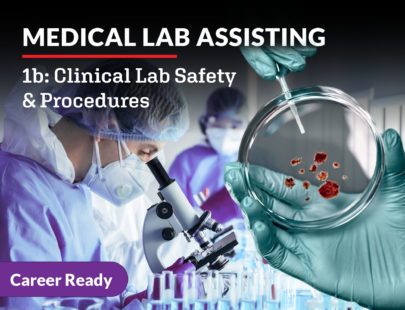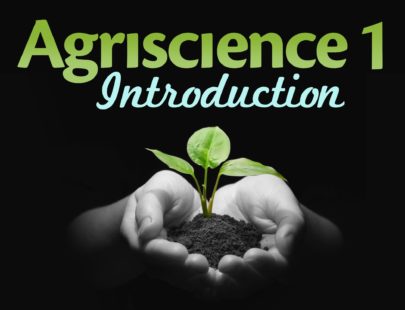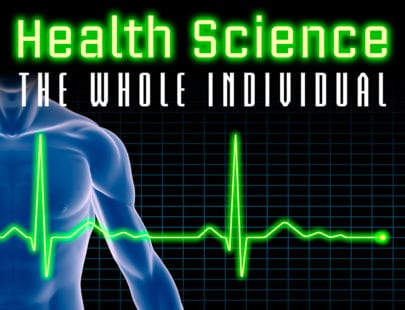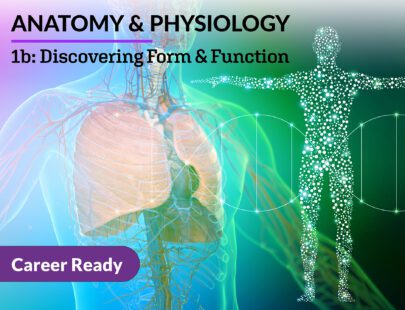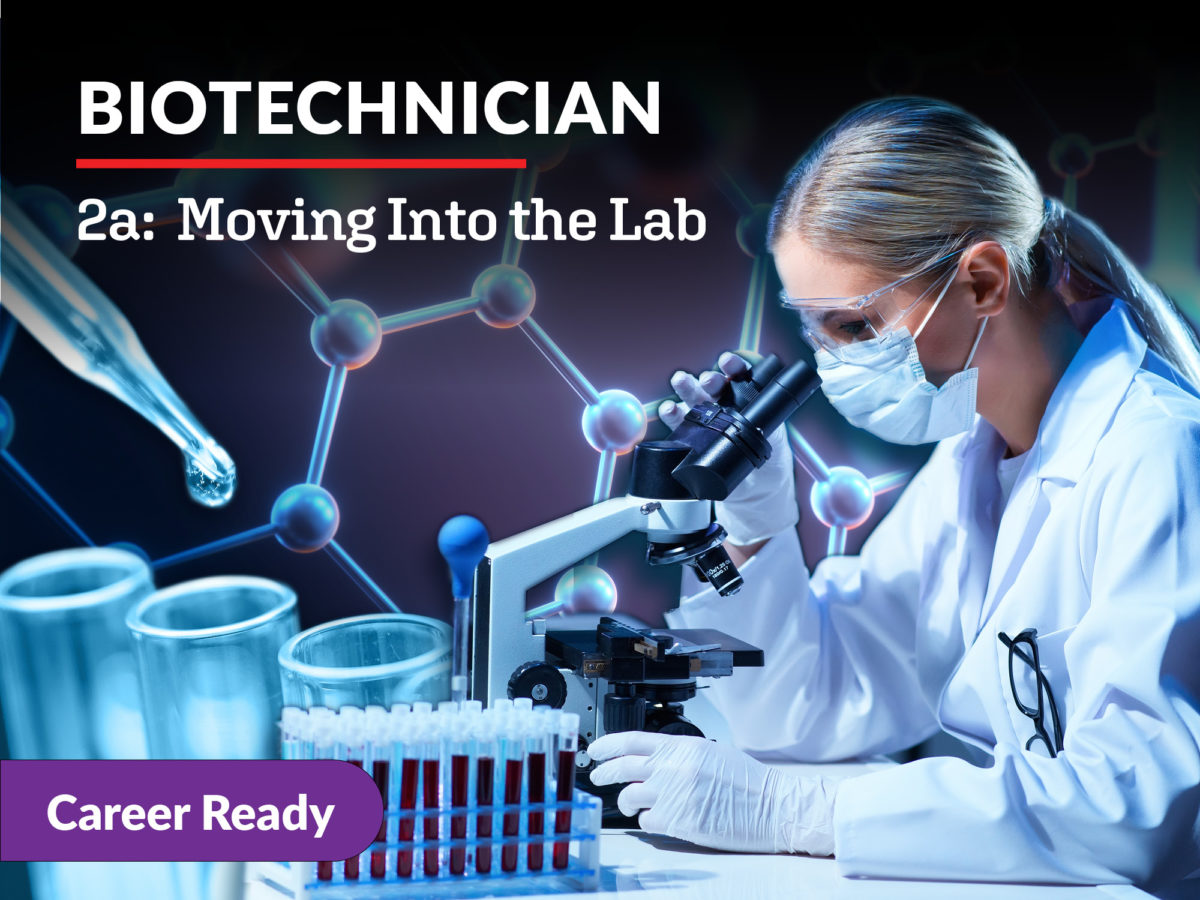
Biotechnician 2a: Moving into the Lab
Are you ready to have an authentic, positive impact on human life? In this course, you will dive even deeper into the role of a biological technician to understand how genetic engineering works. You will explore managing a biotech laboratory, Microscopy and Spectroscopy, mammalian cell culture, what the day-to-day duties of a biotechnician involve, and more. You will also explore experimental design as it relates to genetic engineering to plan your own experiments. Get ready to break down the building blocks of the human design!
Units at a Glance
Unit 1: Managing a Biotech Laboratory
A biotechnology laboratory is a vibrant, exciting place to work, but there are also many potential hazards if supplies and equipment are not well cared for or are used incorrectly. Each lab presents its own unique safety challenges, but one thing is for sure: safety is the responsibility of every member of the research team! The proper labeling, inventory, and storage of all solutions and chemicals is also a joint responsibility. Every team member should exhibit the highest level of ethical behavior and practice professional work habits to ensure the laboratory is safe and effective for all.
What will you learn in this unit?
- Apply safety training techniques in a lab environment including the use of information available from OSHA, SDSs, and SOPs
- Understand how a research team works together to keep the lab safe and functioning
- Accurately label and properly store laboratory solutions, Petri dishes, and samples
- Manage an inventory of laboratory chemicals and supplies
- Maintain and use laboratory equipment safely and effectively
Unit 2: Experimental Design
Did you know that scientists have created mice, monkeys, cats, and even a beagle that “glow in the dark”? These experimental animals are assets for researchers in the study of diseases such as cancer, Parkinson’s, and diabetes. And it all started with a simple experimental question: why does the jellyfish A. victoria glow in the dark? From here, the scientific method was deployed to learn about a green fluorescent protein (GFP) and even identify the gene that codes for it. The discovery and applications of the GFP are shining examples of scientific ingenuity at its finest and serve as an exemplary model of good experimental design. By learning about the journey of the GFP—from curiosity to application—you can apply these methods to your own experimental design someday!
What will you learn in this unit?
- Describe the scientific method and how findings are reported in a scientific journal
- Outline the criteria for an evidence-based scientific experimental design
- Discuss the many applications to medicine and research by the green fluorescent protein from the jellyfish victoria
- Identify sources of bias in the interpretation of scientific data
- Use statistics to minimize bias and quantitate the reliability of data
Unit 3: The Spectrophotometer and the Microscope
A biotechnologist often relies on a dynamic duo of tools in the lab: the microscope and the spectrophotometer. If you intend to purify a protein or the gene coding for a protein, how do you quantitate its purity after each step of your procedure? Spectroscopy can be used to do just this! Spectroscopy is also used to measure enzyme activity and perform routine tests that monitor the health of your heart, kidneys, and liver. How do you observe objects that are invisible to the naked eye? The microscope can visualize cells and tissues using various lenses to magnify the images up to 500,000 times their original size! Both of these tools equip the biotechnician to quantitate macromolecules and visualize living cells. How would you use these tools if you were working in a lab?
What will you learn in this unit?
- Organize the basic equipment list needed for a GFP experiment
- Discuss the theory of spectroscopy and the use of various types of spectrophotometers
- Calculate a standard curve to determine the concentration value for an unknown sample
- Describe how to use a light microscope and the function of each component
- Explain how spectroscopy is used to quantitate DNA, protein, and enzyme activity on ELISA plates
Unit 4: Preparing Solutions
One of the first things a biotechnician does each morning is prepare their solutions for the day. Understanding formulas to properly create solutions and buffers is essential to success—and safety—in the lab environment. One wrong calculation can cause disastrous results. The measure of concentration in the laboratory is molarity or moles per liter. This measure is used in making solutions and buffers, diluting solutions, and more. Math and science go hand in hand—especially in the biotechnology lab. Everyone in the lab must measure correctly and calculate with precision to ensure that experiments are reliable and that everyone is safe. Get your calculators ready—it’s time to prepare our solutions!
What will you learn in this unit?
- Describe solutions and molarity
- Prepare a 1 molar stock solution
- Determine the best glassware to use for measuring volume
- Perform a dilution from a stock solution
- Select the appropriate buffer for an application
Unit 5: Bacteria in Biotechnology
Did you know that the total number of bacterial cells in your body outnumbers your human cells? Most bacteria in the body are helpful, but harmful bacteria have the potential to be lethal. Before the discovery of antibiotics, bacteria caused plagues that killed millions of people. We now grow and culture bacteria in the biotechnology laboratory to create products that save lives. Let’s learn all about bacteria and its impact on the field of biotechnology!
What will you learn in this unit?
- Identify bacteria responsible for major world pandemics
- Follow procedures for growing pure bacterial cultures in the laboratory
- Describe bacterial cell texture, transparency, and pigmentation of a pure culture
- Classify and identify bacteria based on gram staining, oxygen requirements, shape, and morphology
- Explain metabolism and fermentation and differentiate between aerobic and anaerobic respiration
Unit 6: Genetically Engineering Bacteria
Bacteria have made genetic engineering possible. Through the miracle of recombinant DNA technology, a desired human gene can be selected and inserted into a bacterial plasmid. Once the recombinant plasmid is taken up by bacteria, it is gene expressed by the normal cellular machinery because all life recognizes the same genetic code. In this way, a human protein can be made by bacteria on an industrial scale. Biotechnology has turned bacteria into microscopic factories that produce drugs and proteins that help mankind. Let’s learn more about this process and how you can design your own genetic engineering experiment!
What will you learn in this unit?
- Outline the process of bacterial transformation and give examples of how engineered bacterial products are used in everyday life
- Explain the differences between DNA and RNA and the steps involved in prokaryotic gene expression
- Understand the steps needed to create a cDNA library from a specific tissue and isolate a specific gene of interest
- Map a plasmid and design a strategy for using restriction enzymes to create a recombinant DNA pBR322 or pGLO plasmid
- Design an experiment that transforms bacteria to produce a recombinant protein of choice using the pGLO procedure as an example
Unit 7: Mammalian Cell Culture
Most biopharmaceutical drugs today are produced using cultured mammalian cells. Production of proteins in eukaryotic cells instead of bacteria is an advantage because these cells are accurately folded by the eukaryotic machinery and post-translationally modified. Mammalian cells can be cultured from primary or transformed cell lines such as yeast, mammalian CHO cells, and human skin-derived HELA cells. Growth conditions include maintaining constant pH, CO2 levels, and physiological temperature. Specialized culturing is required for growing CAR T-Cells, IPS cells, and embryonic bone marrow cells. Let’s read on to learn more about the details of mammalian cell culture.
What will you learn in this unit?
- Discern the advantages that eukaryotic cell culture offers over bacterial cell culture
- Understand the differences between primary and permanent cell lines and their morphologies
- Demonstrate the conditions for growth and storage of cultured cells
- Explain the process of culturing mammalian cells and the safety concerns about this process
- Discuss the many uses of mammalian cultured cells in genetic engineering and the specialized culturing needs of hybridized CAR T-cells, IPS cells, and bone marrow cells
Unit 8: Purification of Proteins
A cell contains hundreds of proteins, each performing specialized functions. A protein can be isolated from this population by exploiting its unique physical characteristics. To start with, organelles containing that protein are separated by subcellular fractionation. Following this, different forms of chromatography are used to separate proteins based on their size, charge, hydrophobicity, and glycosylation. Lastly, proteins are characterized for purity using high-pressure liquid chromatography (HPLC), gas chromatography (GC), or polyacrylamide gel electrophoresis (SDS-PAGE) followed by Western blotting. Let’s read on to find out more about this exciting process and how it is applied in the field of biotechnology!
What will you learn in this unit?
- Develop a strategy for the purification of a protein based on its physical characteristics and location in the cell, serum, or media
- Describe a procedure for purifying a protein using gel exclusion chromatography, ion-exchange chromatography, or affinity chromatography
- Analyze the purity of an isolated protein using SDS-PAGE, HPLC, or GC and enzyme assay
- Explain a typical procedure used to purify a protein from blood, whole tissue, or bacterial cells
Required Materials
Physical
- Bag of M&M’s candy with blue, orange, green, yellow, red, and brown colors
Software
- Word processing software
Optional
- Art supplies
- Audio recording device
- Balloons
- Calculator
- Flasks with gas spigots (5)
- Glucose/sugar
- Graphic design software
- Heater
- Image editing software
- Litmus paper
- Presentation software
- Spreadsheet software
- Video recording device
- Water
- Writing supplies
- Yeast

